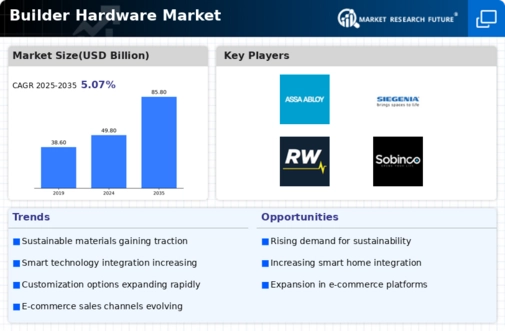Builder Hardware Size
Builder Hardware Market Growth Projections and Opportunities
The Builder Hardware Market is influenced by a multitude of factors that collectively shape its landscape. One of the primary driving forces is the global construction industry's performance. As construction activities surge worldwide, there is a corresponding increase in the demand for builder hardware products such as locks, handles, hinges, and other essential components. The growth in residential, commercial, and infrastructure projects contributes significantly to the expansion of the builder hardware market.
Builder hardware refers to a category of metal hardware specifically used for protection, convenience, and decoration in buildings. These pieces of equipment are usually responsible for supporting fixtures, such as doors, windows, and cabinets. Some of the most common examples of builder hardware include door handles, bolts, door hinges, switch plates, and letter plates.
Technological advancements play a crucial role in shaping the market dynamics of builder hardware. Innovations in materials, manufacturing processes, and product design enhance the functionality, durability, and aesthetics of builder hardware products. Manufacturers adopting cutting-edge technologies can gain a competitive edge by offering products that meet evolving customer preferences and industry standards. This factor underscores the importance of research and development in driving market growth and sustaining competitiveness.
The real estate market's health is closely linked to the builder hardware sector. Fluctuations in property development, housing demand, and commercial real estate activities directly impact the demand for builder hardware products. Economic factors, interest rates, and government policies affecting the real estate sector have ripple effects on the builder hardware market, influencing purchasing decisions and overall market growth.
Regulatory compliance and standards also significantly affect the builder hardware market. Stringent regulations related to safety, quality, and environmental impact influence product design, manufacturing processes, and the materials used. Adherence to these regulations is essential for market players to build trust among consumers, comply with industry standards, and navigate the global market landscape successfully.
The builder hardware market is intricately tied to the overall economic conditions, including inflation rates, currency exchange rates, and economic stability. Economic downturns can lead to reduced construction activities and capital investment, impacting the demand for builder hardware products. Conversely, economic growth and stability create a favorable environment for increased construction and, subsequently, heightened demand for builder hardware.
Raw material prices, particularly metals such as steel and aluminum, have a substantial impact on the builder hardware market. Fluctuations in commodity prices can affect production costs, subsequently influencing product pricing and profit margins. Market players need to carefully monitor and manage raw material costs to remain competitive in the market and maintain profitability.
The level of urbanization and population growth also contributes to the dynamics of the builder hardware market. As more people move to urban areas and construction activities intensify, there is a heightened need for builder hardware products to support housing and infrastructure development. Demographic trends, such as increased homeownership and renovation activities, further influence the demand for builder hardware.
Competition within the builder hardware market is intense, with numerous manufacturers vying for market share. Differentiation through product quality, design, and brand reputation is crucial for companies seeking a competitive advantage. Pricing strategies, distribution channels, and customer service also play pivotal roles in determining a company's success in this competitive market.
Environmental sustainability is becoming an increasingly important factor in the builder hardware market. Growing awareness of environmental issues prompts consumers and industry players to prioritize eco-friendly materials, manufacturing processes, and product life cycles. Companies that embrace sustainability practices and offer green alternatives are likely to attract environmentally conscious consumers and gain a competitive edge in the market.









Leave a Comment